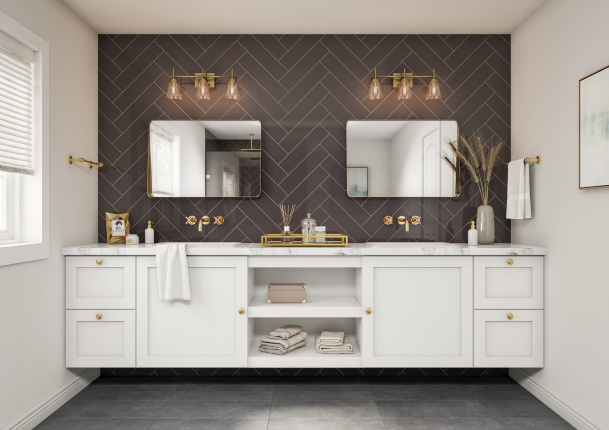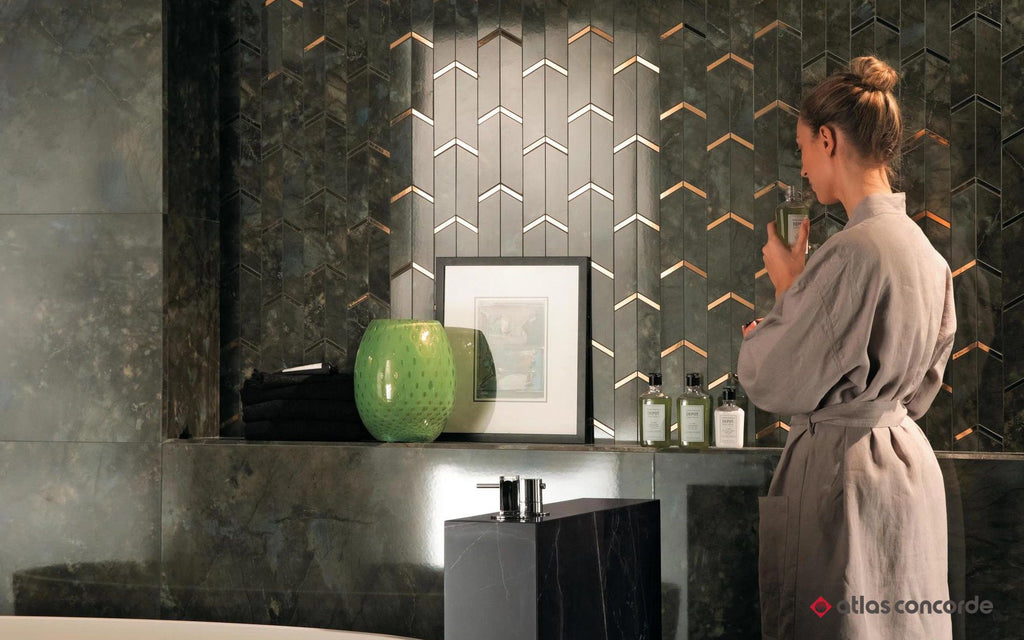If you want to turn any space into a functional and stunning part of your home, you need to start from the ground up. And no, we don't mean digging foundations. We’re talking about getting the perfect floor tiles!
Tiles can breathe life into a room, making it a place where you love to spend time, entertain guests, or simply relax. At D&B Tile, we’re here to offer the best tiles in the market and offer expert advice when installing your new floors.
In this blog, you’ll learn what to expect when you take on a tile installation project in Doral with professionals like us, from picking the right product to adding those final touches.

Step 1: Choosing the Right Tile
Selecting the perfect tile is like choosing the right ingredient for a recipe — it makes all the difference. Some of the most popular tile flooring options include:
Porcelain Tiles
Porcelain tiles are among the most durable options available and can withstand heavy foot traffic. Since they’re made from a dense clay fired at high temperatures, they don’t absorb water and moisture from the air. As a result, they’re easy to clean and don’t get stains or cracks easily.
The quality and strength of porcelain, while certainly impressive, do come with certain considerations to keep in mind. For instance, these tiles are heavy and might require extra floor reinforcement during installation.
Porcelain tiles can also be less comfortable underfoot because they’re hard, so using rugs or mats in areas where you frequently stand on can provide added comfort.
Porcelain tiles are best suited for high-traffic areas like entryways, kitchens, and bathrooms. They're also an excellent choice for outdoor spaces, which often get wet and are subject to temperature changes.
Ceramic Tiles
Ceramic tiles are made from clay mixed with other natural materials and fired at lower temperatures than porcelain. They come in glazed and unglazed finishes, and offer a wide range of design options, from traditional to contemporary.
Ceramic tiles are generally lighter and easier to handle during installation. Yet, they aren’t as tough and may not withstand heavy traffic as well. Unglazed ones are also porous and may require sealing to prevent staining.
Ceramic tiles are excellent for decorative use in living rooms, bedrooms, and kitchens, while glazed ones are often preferred for bathroom walls and kitchen backsplashes.
Glass Tiles
Glass tiles are made from melted glass that is then cooled to create tiles of different shapes and sizes, and they can have a glossy or matte finish. Glass is non-porous and easy to clean, making it a suitable choice for areas prone to moisture.
On the other hand, glass tiles can be more delicate and susceptible to chipping or cracking, and they tend to be more expensive than ceramic or porcelain tiles.
Glass tiles are perfect for creating decorative accents, backsplashes, and feature walls. They are not typically recommended for high-traffic flooring but you can use them in bathroom walls and shower areas.
Mosaic Tiles
Finally, mosaic tiles come in various materials, including glass, ceramic, and natural stone. They are small, usually square, and mounted on mesh or paper sheets. Mosaic tiles can add texture and depth to a space, creating visual interest.
Installing mosaic tiles can be more time-consuming due to their small size, and grout lines in mosaic installations require more attention to remain clean.
Mosaic tiles are ideal for creating unique patterns and accents in both residential and commercial spaces. They are commonly used in bathroom and kitchen backsplashes and shower floors.
Step 2: Measuring and Estimating
To make sure you get the right amount of tile, here's a simple way to estimate:
- Calculate the Area: Measure the length and width of the space where you intend to install tiles, and multiply these measurements to determine the square footage.
- Add for Wastage: Always try to account for wastage, which can occur due to cutting or replacing tiles during installation. Adding an extra 10% to your square footage calculation ensures you have enough tiles to cover your project.
- Expert Consultation: For an even more accurate estimate, consult with our experts at D&B Tile. We'll take your project's specific needs into account, helping you avoid underestimating or overordering tiles.

Step 3: Installing the Tiles
Setting up the Workspace
Before the installation begins, professionals need to set up the workspace. They remove and cover all furniture and fixtures in the installation area to create a clean, open space for work.
Surface Preparation
In this stage, tile installers check the condition of the subfloor to determine if they have to address any unevenness, cracks, or damage needs. Then, they do repairs to create a smooth and level surface for your new tiles.
Depending on the place for the flooring project, such as a bathroom or kitchen, experts will need to apply waterproofing and underlayment materials to protect against moisture and create a stable base for the tiles.
Tile Layout and Design
The next step is planning the layout and design of your tiles. This is where your vision starts to take shape, as you work closely with the installer to choose a tile pattern that complements your space.
You also need to decide on the tile layout, which could be a traditional grid or a more intricate design. Before applying the adhesive, professionals do a dry layout to ensure the tiles fit and align perfectly.
Tile Cutting and Fitting
Installers use the appropriate tools, such as tile cutters or saws, to make precise cuts on the tiles to fit into corners, edges, or irregular spaces. Professionals are careful and precise, making sure each tiles fits, even around obstacles like plumbing fixtures or electrical outlets.
Adhesive and Grout Application
Professionals select the right adhesive based on the tile type and the surface they're working on. Then, they apply the adhesive to establish a robust bond between the tiles and the substrate. Finally, they use grout to fill the gaps between tiles and craft clean, even lines.
Setting and Leveling the Tiles
Professionals use various tools and techniques, such as spacers and leveling systems, are used to ensure that tiles are set evenly. This step prevents tile lippage, which is when tiles are uneven and do not align.
Professional installers always pay close attention to detail and make adjustments as needed during installation to ensure a level and visually pleasing result.
Curing and Drying Time
Once the tiles are in place, they require some time to dry and set. The installation team will let you know how long you should wait for the adhesive and grout to do their job. This waiting period is important to make sure the tiles stick well and the installation is solid.
During this time, we keep an eye on how things are drying and setting to make sure everything is going as planned.
Post-Installation Issues and How to Address Them
Congratulations, your tile installation is complete, and your space looks fantastic! However, just like any home improvement project, there might be some post-installation issues that can pop up.
Let's take a look at common post-installation concerns and how to tackle them:
Grout Discoloration
Grout can change color over time due to dirt and moisture, appearing darker or discolored. To maintain its original appearance, regularly clean grout with a mild cleaner and a soft brush. Occasional resealing can also help.
Tile Cracks or Chips
Tiles may develop small cracks or chips, particularly in high-traffic areas, due to factors like heavy impacts or structural movement. You can replace damaged tiles individually without redoing the entire installation.
Contact a professional to assess and replace the affected tiles, restoring your space to its flawless appearance.
Grout Cracking
Over time, grout cracks or loosens between tiles. This problem can happen due to factors like settling of the building, temperature changes, or simply wear and tear from daily use. The good news is that there's a straightforward solution called re-grouting, where professionals remove the old, damaged grout and replace it with fresh grout.
Regrouting ensures a tight bond between the tiles, preventing further cracking and maintaining the strength and appearance of your tile installation.
Loose or Hollow-Sounding Tiles
Finally, you might notice that some tiles sound hollow or seem a bit loose when tapped. Unaddressed loose tiles can lead to more significant damage down the line, such as cracks, compromised waterproofing, and structural issues.
To put an end to this problem, professionals start by removing the loose tiles and preparing the surface beneath. Then, they apply a high-quality adhesive and place the tiles back into position, ensuring a flush fit.
Experts also apply grout to the gaps, clean the excess, and inspect the area to see if all the tiles are securely in place.

Ready to Transform Your Space with Beautiful Tile Installation in Doral?
At D&B Tile, we bring years of expertise and the finest tile suppliers to your project. Get started on your tile journey by reaching out to our dedicated team.
We're here to assist you every step of the way, from choosing the perfect tile to achieving a flawless installation. Call us today!


